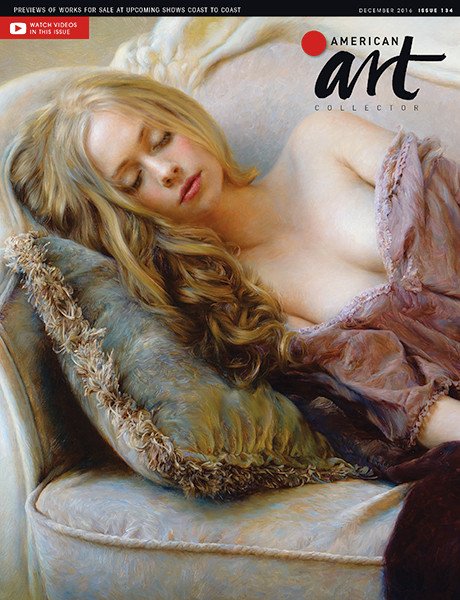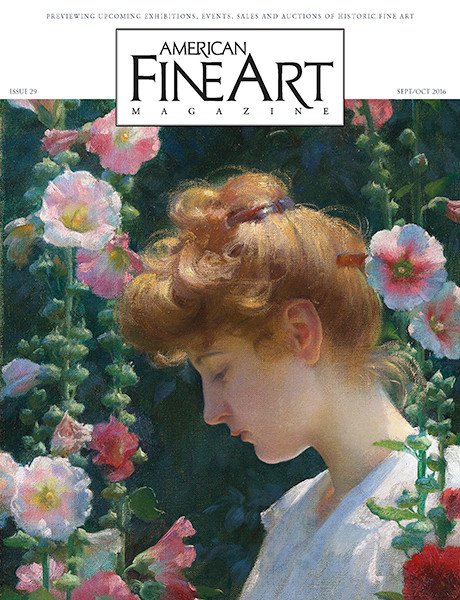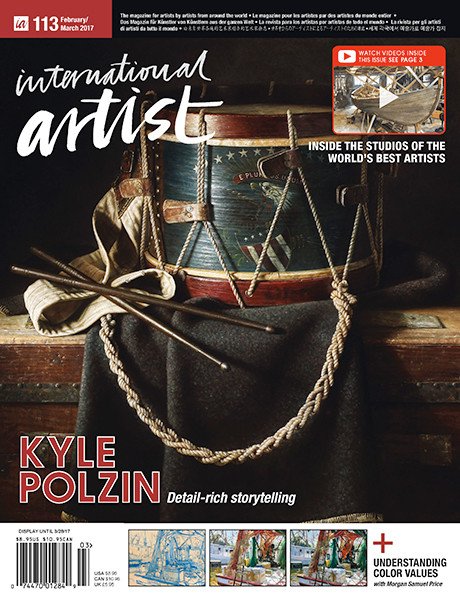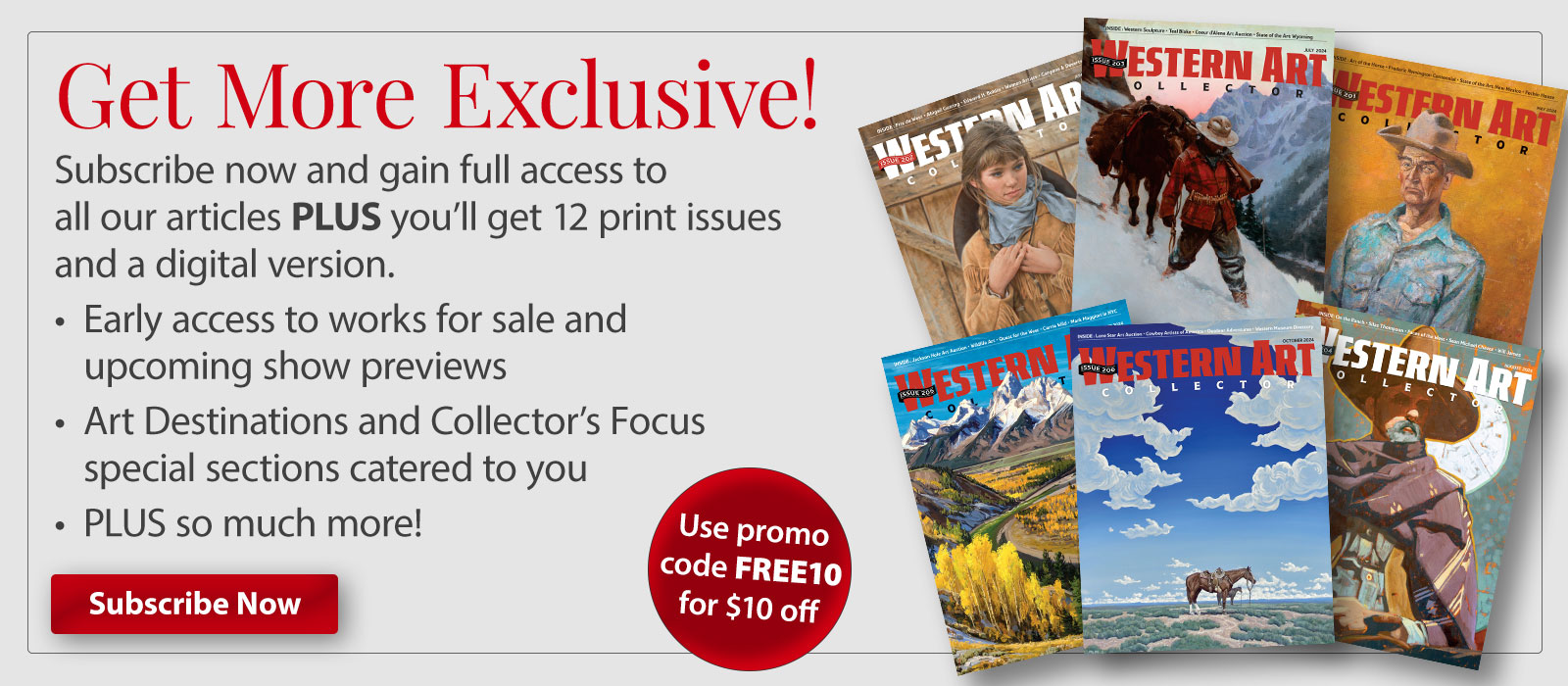It is frequently perceived that narrative and story originate with human subjects. Our human brains can immediately identify with other humans—call it species bias. And yet, animals, and the artists who depict them, can translate stories across the species barriers that nature has established.
Consider one of the masters of wildlife art, Bob Kuhn. The artist from Arizona, by way of New York and Connecticut, expertly painted all varieties of animals from nearly every continent. He was lauded during his lifetime—and since his death in 2007—for the magnificence of his brushwork, the accuracy of his animals and the lusciousness of his color palette. But more than anything, Kuhn painted stories of animals, stories that were inherently about his wildlife subjects but were also imbued with human drama.
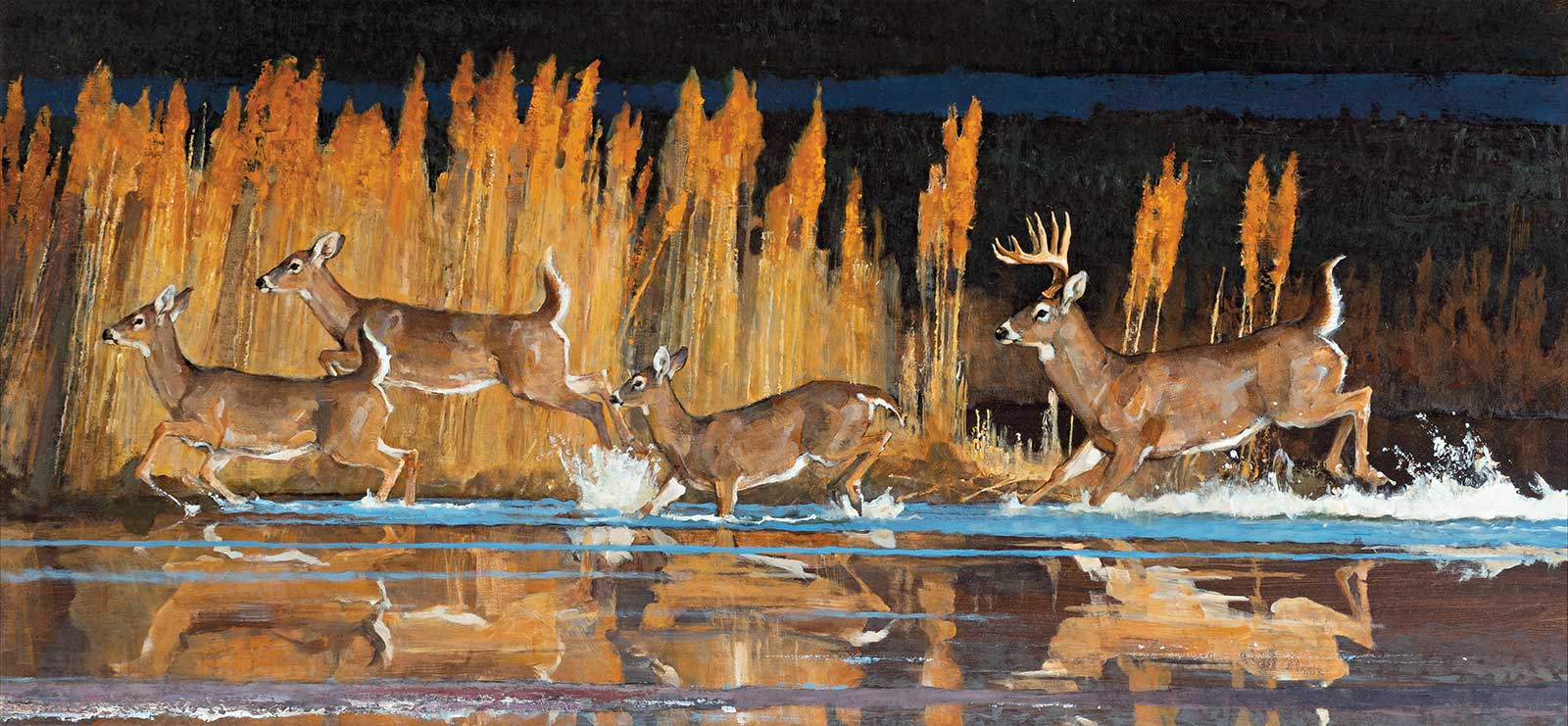
Bob Kuhn (1920-2007), Running Wild, acrylic on board, 20 x 42 in.
A painting of a bear easily swiping at leaping fish became a story of prosperity. A painting of a polar bear chasing away an arctic fox or a lion leaping at vultures became analogies about competition. Images of predator and prey became stories of survival. Consider paintings here: Running Wild is quietly a story about family, while Reverberations is about being outwitted and outmaneuvered, and ultimately a story of doom and defeat.
Kuhn was not the first to fill his paintings with subtext that both glorified and transcended the animal subjects, nor will he be the last, but he is certainly one of the masters. His flare for drama in his wildlife works was clearly evident as early as the 1940s and 1950s, when he began selling illustration to outdoor and pulp magazines, and remained even as he transitioned away from illustration into fine art, and then continued onward to become one of the legends of the genre.
Not every wildlife painting or sculpture is a grand metaphor for human emotion or drama. Some works are purely about the animal and their beauty, their habitat or their role within nature. Regardless of the artist’s intent or perspective of the subject, wildlife works offer stunning opportunities for art viewers who wish to step into the wild and explore the world through the eyes of the animals. Bob Kuhn would approve.
In these pages, we celebrate our annual wildlife special section, which focuses exclusively on animals. These are galleries, artists and museums that explore this fascinating genre.
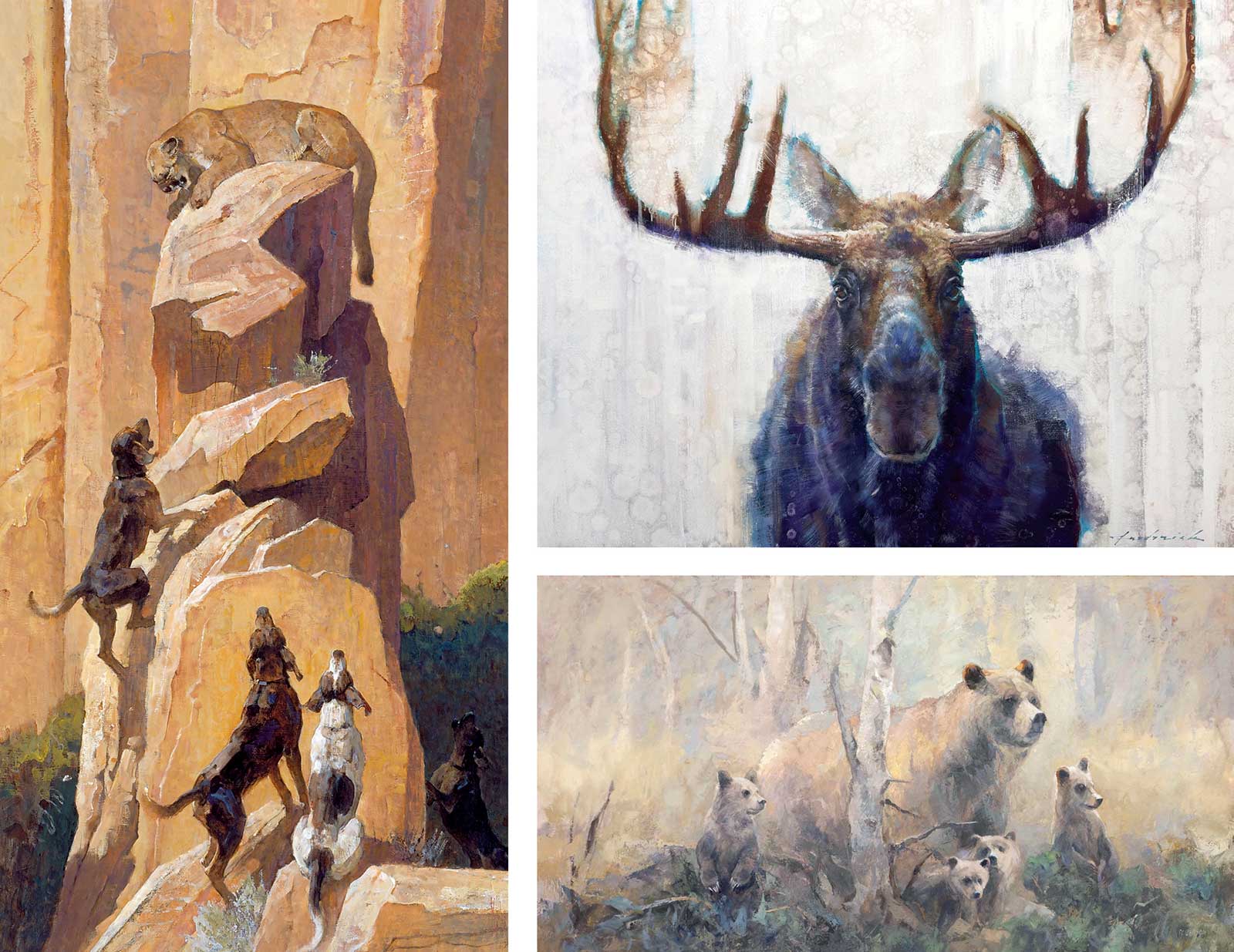
Clockwise from left: Bob Kuhn (1920-2007), Reverberations, 1991, acrylic, 40 x 22 in. National Museum of Wildlife Art, Jackson Hole, WY.; Altamira Fine Art, After the Rain, oil on canvas, 48 x 60 in., by David Frederick Riley; Altamira Fine Art, Poetry, oil on canvas, 39 x 72 in., by Mary Roberson.
Many galleries, such as Manitou Galleries, based in Santa Fe, New Mexico, represent a wide range of wildlife art by some of the best artists working today. Andrew Bolam is one such artist, whose work is deeply rooted in his childhood fascination with the American West—a love he has further explored through extensive travels across its deserts, mountains and plains. Balancing tradition with a contemporary style, his bold color palette and graphic compositions offer viewers a fresh perspective on familiar themes, creating a sense of nostalgia interwoven with innovation. A highlight from his wildlife subject matter is seen in the bear painting A Mother’s Love.
Additional artists at Manitou include Aaron Hazel, who paints with an energetic looseness while maintaining high levels of realism, as in the case of his donkey portrait, Sherman. David Frederick Riley uses color harmonies to showcase emotion and the vibrancy of life. His work frequently illustrates themes of emotional and spiritual growth. While his focus is usually fixed on the human form, he also depicts animals like the longhorn, like in Hook ‘Em.

Three magazines with Bob Kuhn covers: True (1973), Outdoor Life (1967) and Field & Stream (1959).
“At Altamira Fine Art, we are proud to represent artists whose work reflects a deep reverence for wildlife and the Western landscape,” says owner Jason Williams. “David Frederick Riley, for instance, distills the essence of iconic animals into bold, contemporary forms—his use of contrast and abstraction invites viewers to engage with familiar subjects in unexpected ways. Mary Roberson’s work feels like a memory, her intuitive brushwork and earthy tones evoke not just animals, but the atmosphere they inhabit, blurring the line between seen and felt. Stephanie Revennaugh brings an emotional and sculptural sensitivity to her equine subjects. Her bronzes are fluid and expressive, capturing not just the anatomy of the horse but its spirit, movement and quiet strength.” Though distinct in style, each artist shares a commitment to honoring the animals of the American West, not just as symbols, but as sentient presences deserving of attention, respect and artistic inquiry.
When collecting wildlife art, Williams suggests looking for “work that conveys both anatomical understanding and emotional depth. The best pieces do more than represent animals, they reflect the artist’s respect for their subject and invite a deeper appreciation for the natural world.”
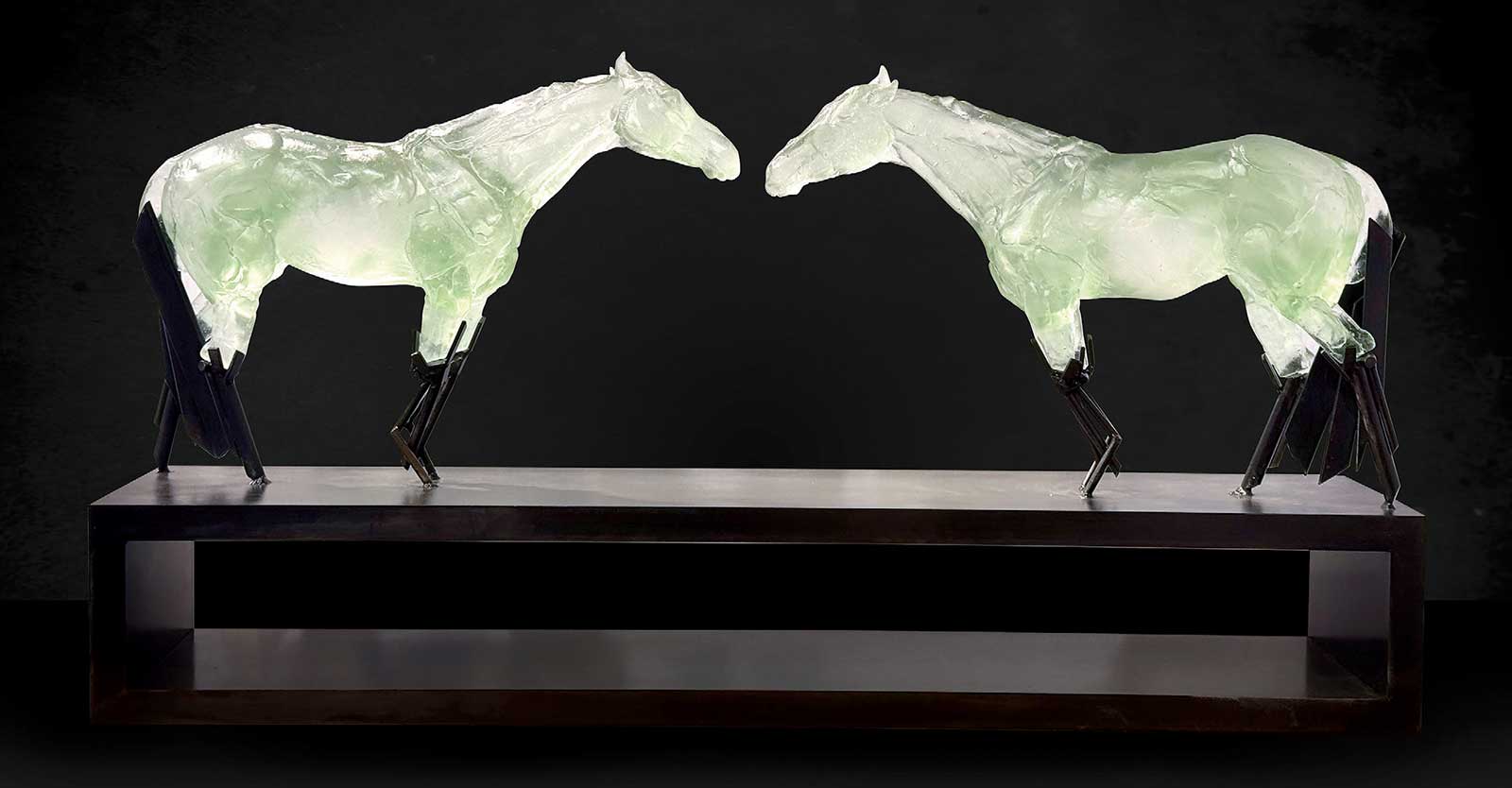
Altamira Fine Art, Magnetic, glass and steel, 18 x 36 x 8 in., by Stephanie Revennaugh.
The National Museum of Wildlife Art, founded in 1987, is a world-class art museum holding more than 5,000 artworks representing wild animals from around the world. Western Visions is the museum’s largest and longest-running fundraiser and is one of the signature events of the Jackson Hole Fall Arts Festival. The 38th Annual Western Visions Art Show + Sale will be on view at the museum from September 6 to 28. Top contemporary wildlife artists and collectors from around the world will be congregating for the evening sale on Thursday, September 11.
“All works in this year’s sale will be offered by fixed price draw. Artists in the large format section of the sale were tasked with responding to the theme ‘Wonder’—taken directly from the museum’s mission statement: Impart knowledge and generate wonder through art and education,” says museum representatives. “From pondering the vastness of the animal (and human) experience to reveling in the splendor of nature’s beauty, these works truly do generate wonder.”
“The wildlife in America is as diverse as anywhere in the world, and the exhilaration of witnessing animals in their natural habitat never wanes,” notes Coeur d’Alene Galleriesowner, Buddy Le. “Wildlife art captures our imagination as much as seeing a moose in the wild or reminds us of that mountain goat we spotted on that family trip to Glacier National Park.”
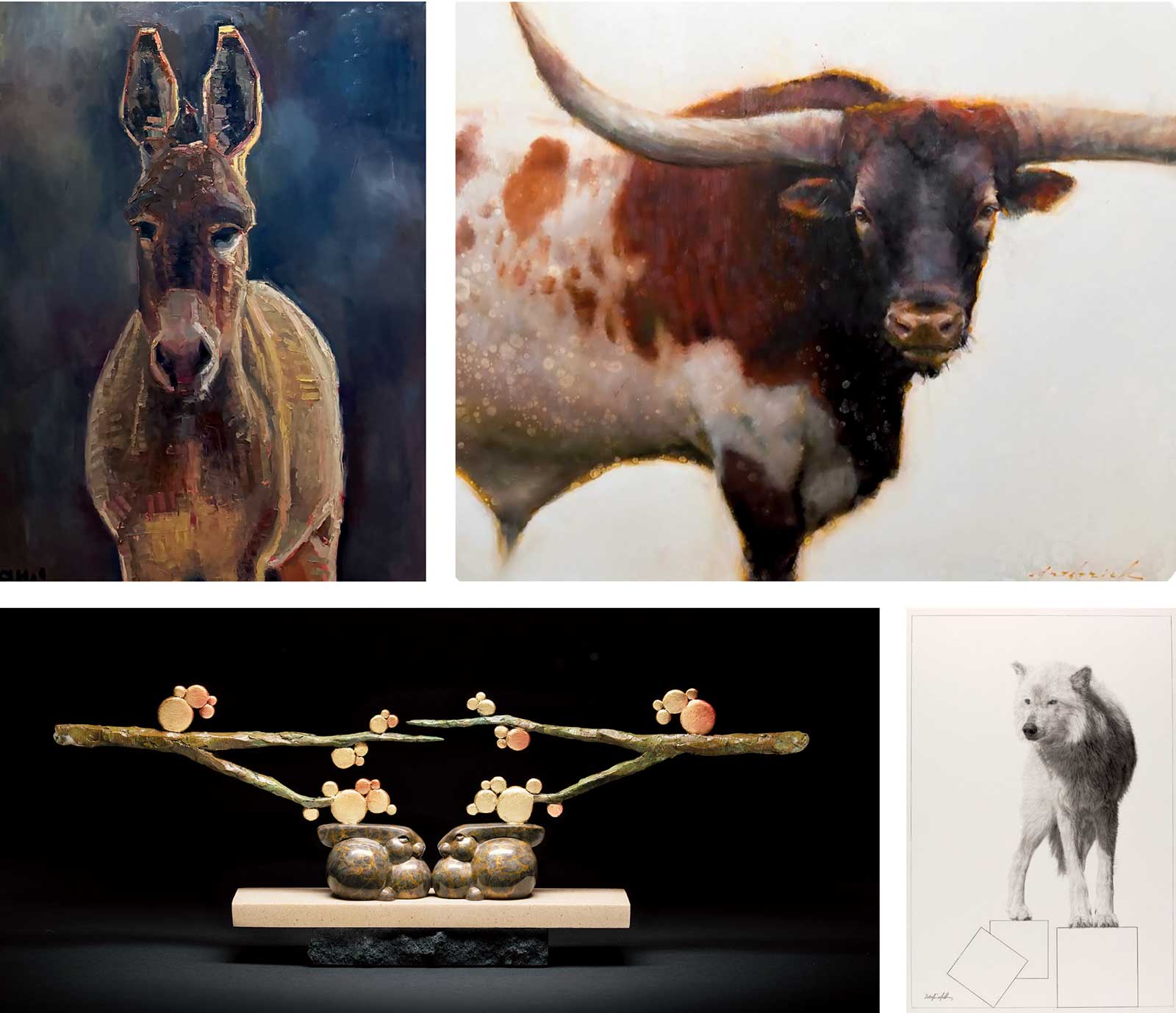
Top: Manitou Galleries, Sherman, oil, 48 x 36 in., by Aaron Hazel; Manitou Galleries, Hook ‘Em, oil, 48 x 60 in., by David Frederick Riley. Bottom: National Museum of Wildlife Art, Aspen Undercover, bronze ed. 12 of 18, 9 x 23 x 3 in., by Tim Cherry. Available at the Western Visions Art Show + Sale; National Museum of Wildlife Art, Delicate, graphite on archival paper, 24 x 16 in., by Dale Marie Muller. Available at the Western Visions Art Show + Sale.
The Idaho gallery represents Dustin Van Wechel, whose painting Woolly Wanderers marries the landscape with its wildlife inhabitants and portrays them in a way that evokes an emotion rather than just rendering an animal. Because Van Wechel spends a lot of time observing his subject matter in the wild, he’s able to bring an authenticity to his work that really appeals to collectors. Nicholas Coleman also likes to add story to his paintings, seen in works like Ready to Fish, and strives to preserve the fading history of the American West. Abigail Gutting applies her unique style and brushwork to create a mood, like in Light of the Hunter’s Moon. The bull elk has long been a favorite subject matter for wildlife enthusiasts due to the adrenaline of archery hunting and the majesty and size of elk.
“My advice for collectors is to always focus on quality regardless of the artist,” says Le. “A quality painting will always bring you joy and will also add value to your collection.”
Carrie Wild, owner of Gallery Wildin Jackson Hole, shares that she’s constantly inspired by the deep-rooted connection that her gallery artists have with the natural world. “Each of them carries a reverence for wildlife that goes beyond observation—it’s about relationship, presence and respect,” she says. “You can feel that in their work. Whether it’s the precision and power of Doyle Hostetler’s stoic wildlife portraits, the layered emotion in Patricia Griffin’s color studies or the bold energy in Amber Blazina’s brushwork, these are not just images of animals—they’re invitations to see the world through their eyes.”
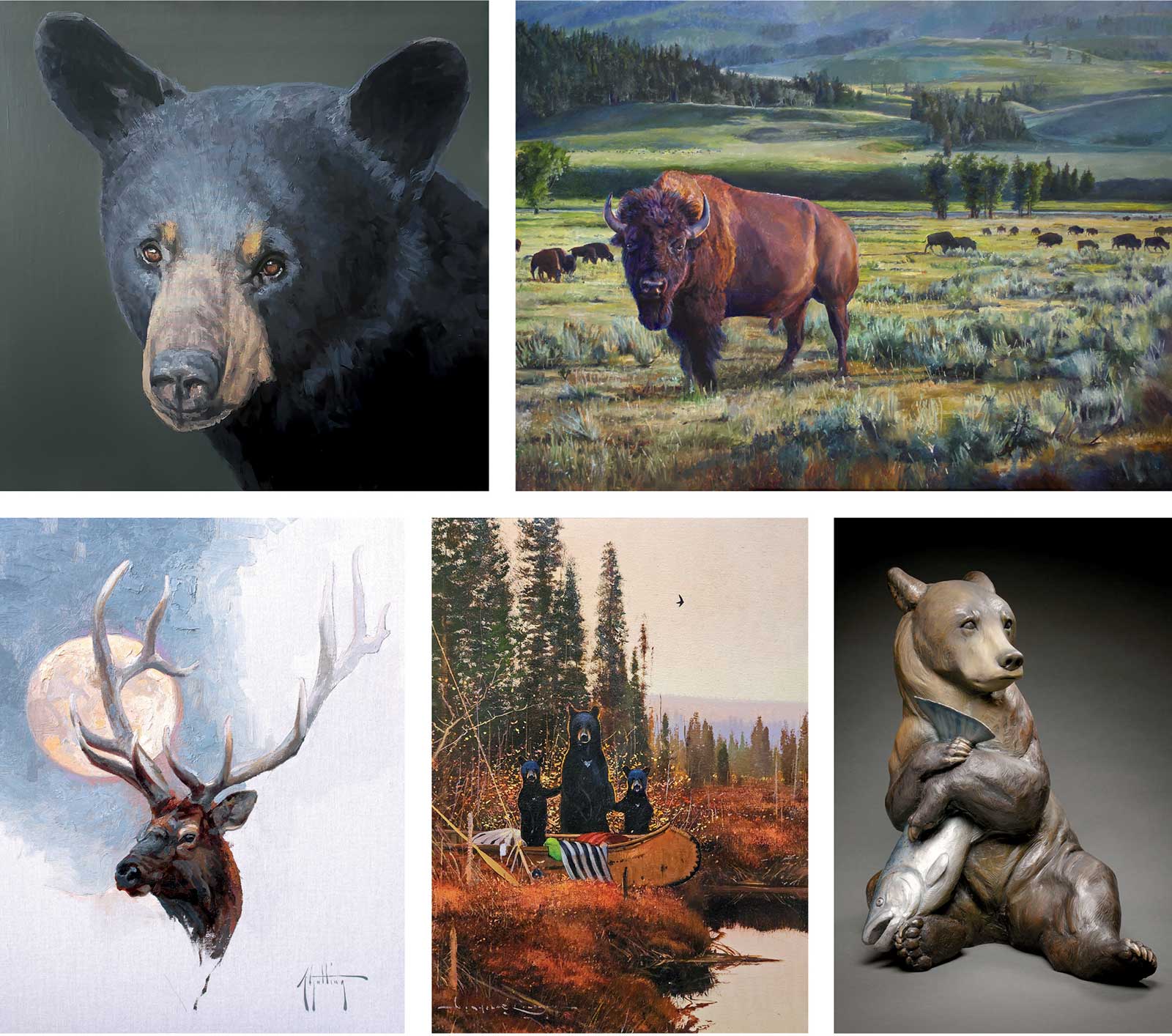
Top: Manitou Galleries, A Mother’s Love, oil, 48 x 48 in., by Andrew Bolam; National Museum of Wildlife Art, The Lamar Valley (Get Back in Your Car Karen), oil on canvas, 30 x 40 in., by Dan Knepper. Available at the Western Visions Art Show + Sale. Bottom: Coeur d’Alene Galleries, Light of the Hunter’s Moon, oil on linen, 20 x 16 in., by Abigail Gutting; Coeur d’Alene Galleries, Ready to Fish, oil, 24 x 18 in., by Nicholas Coleman; Mountain Trails Gallery Sedona, Prized Possessions, bronze, limited ed. 20, 21 x 18 x 20½ in., by Raymond Gibby.
Wild continues, “Wildlife, in all its beauty and vulnerability, reminds us of our place within something much larger. And that’s really at the heart of what we do here. We believe that art has the power to not only reflect nature, but to protect it—by sparking curiosity, empathy and connection. Our hope is that when someone stands in front of one of these paintings or sculptures, they feel that spark. They feel wonder. And from that place, they’re moved to care—not just about the artwork, but about the wild places and beings it represents.”
The inspiration for wildlife artists at Mountain Trails Gallery Sedona comes from their enduring love of nature. Each animal’s unique characteristics and symbolism reveals a story captured by the artist. “Observing and often meeting wildlife is not common, but our artists go to great lengths to satisfy their curiosity,” says gallery director Julie R. Williams. “Perception often requires quick action while in the field, and other times it is arduous with long hours of observing the different stages and phases of life, and these outstanding artists have captured a variety of unique and delightful moments.”
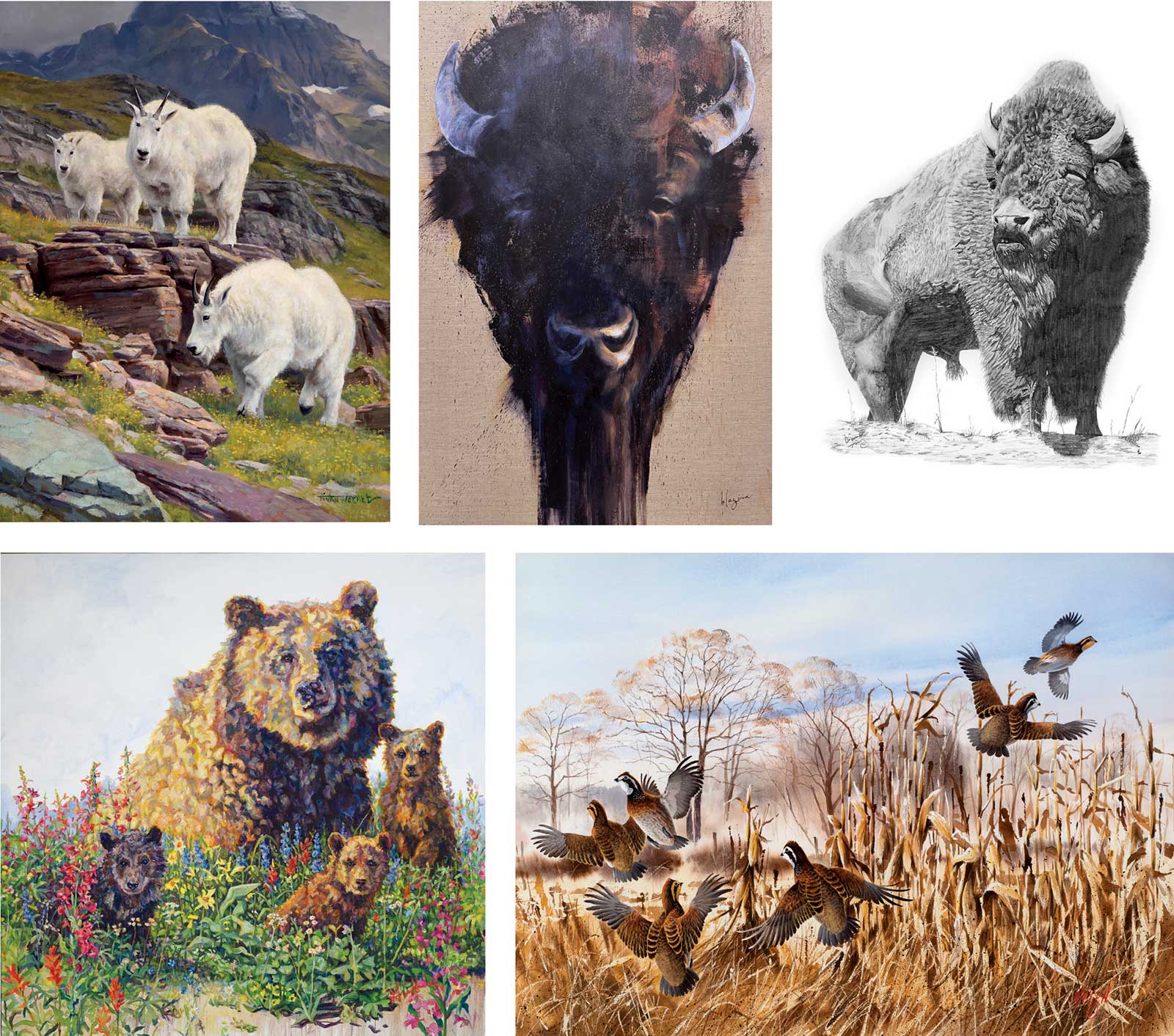
Top: Coeur d’Alene Galleries, Woolly Wanderers, oil on linen, 24 x 18 in., by Dustin Van Wechel; Gallery Wild, Resolute, oil on linen, 72 x 48 in., by Amber Blazina; Duane Frey, Legacy, graphite, 15½ x 11½ in. Bottom: Gallery Wild, Blossoms, oil on linen, 48 x 48 in., by Patricia A. Griffin; Southeastern Wildlife Exposition, Covey Rise, watercolor, 28 x 37 in., by Jim Killen.
This includes Jerry Salinas’ apex mammals of North American that are bigger than life; Jeremy Bradshaw’s clever compositions and remarkable patinas within the avian world; and the always perceptive Raymond Gibby, who finds so many human traits that come forward in his wildlife subjects. All these artists, and more, have remarkable things to say.
When collecting, Williams says to, “First, find an artist whose style resonates with your aesthetic sense, then consider the way in which the artwork grabs your attention. Also, consider if the work touches your passion for connecting with nature, or does it simply make you smile? If it meets any of this criteria, then don’t overthink it. Take it home and allow for all the nuances to unfold and bring you joy!”
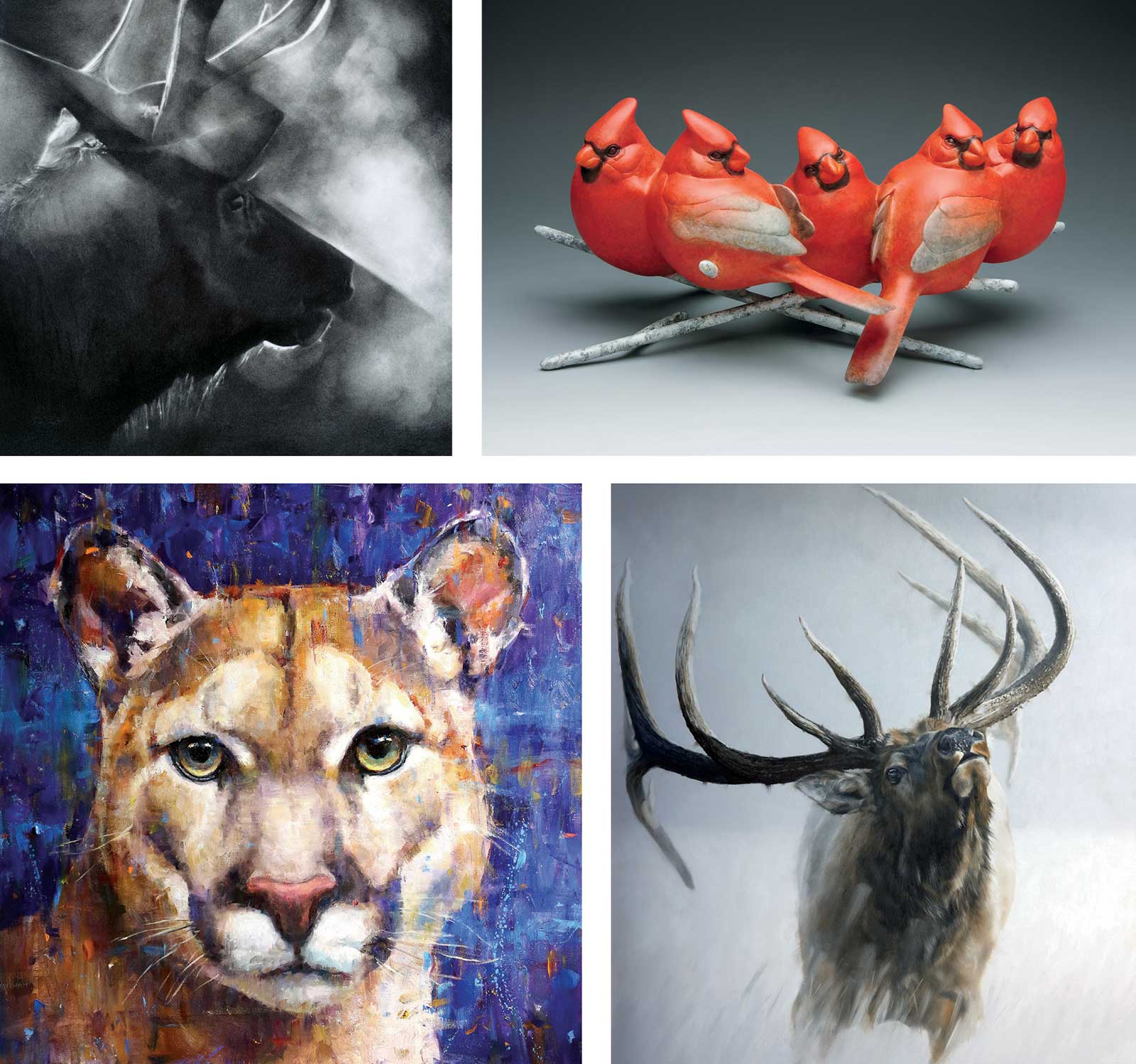
Top: Southeastern Wildlife Exposition, Condense, charcoal, 20 x 20 in., by Ray Gamradt; Mountain Trails Gallery Sedona, House of Cards, bronze, ed. of 40, 6 x 14 x 9 in., by Jeremy Bradshaw. Bottom: Mountain Trails Gallery Sedona, Mountain Eyes, oil, 30 x 30 in., by Jerry Salinas; Gallery Wild, Challenge Accepted, oil on canvas, 60 x 60 in., by Doyle Hostetler.
Clearly, Jackson Hole is home to impressive institutions, galleries and museums inspiring generations of wildlife artists, and has therefore become a natural hub for wildlife art collectors. “The mountainous West has long been a destination for wildlife enthusiasts, so it comes as no surprise that wildlife art has been, and remains, a cornerstone of what we do,” says Kevin Doyle from Jackson Hole Art Auction. “Our upcoming live auction on September 13, which is part of the Jackson Fall Arts Festival, offers paintings from highly collected wildlife masters like Carl Rungius, Bob Kuhn, Tucker Smith and Ken Carslon, as well as sculpture from Antoine-Louis Barye and Dan Ostermiller.”
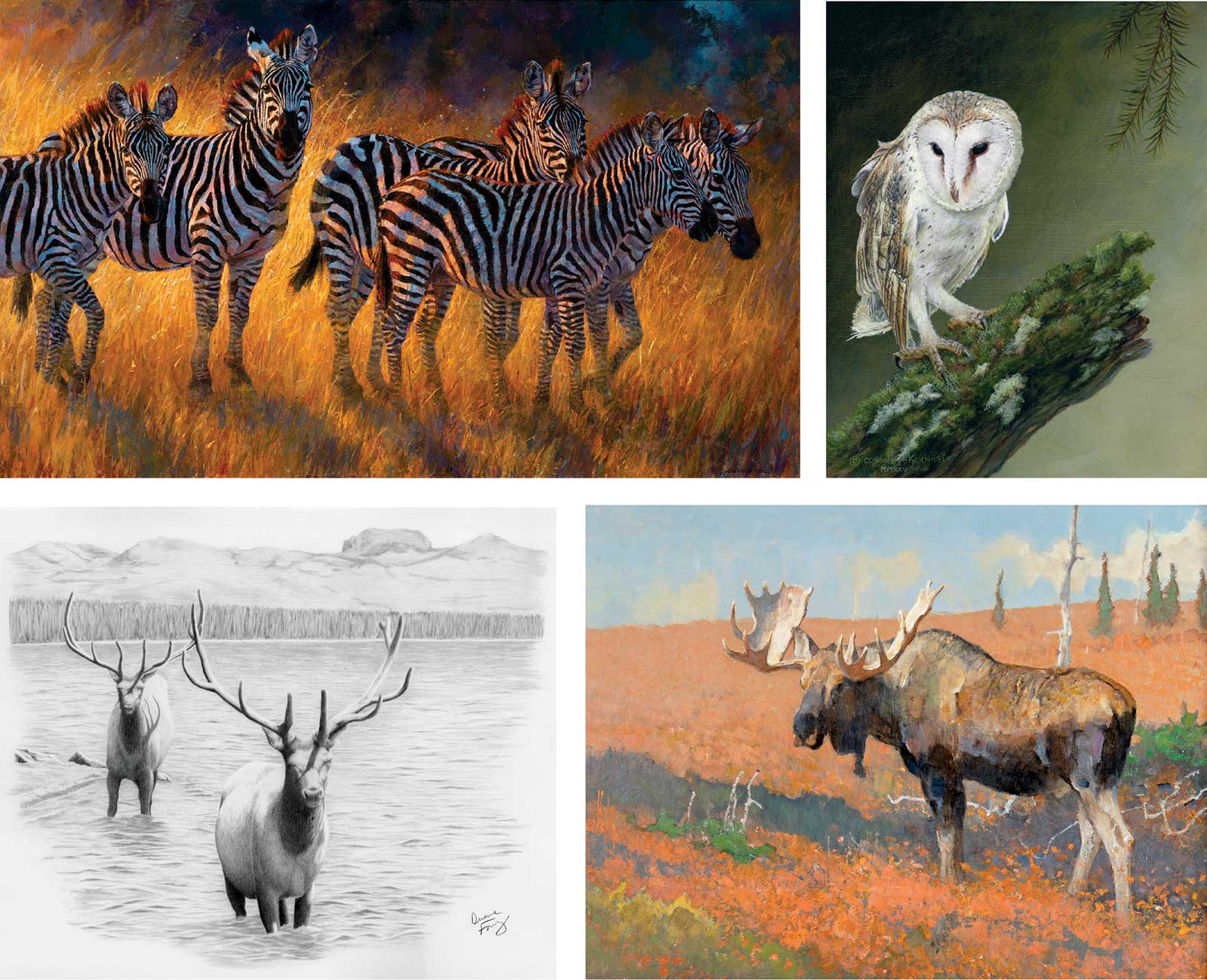
Top: Southeastern Wildlife Exposition, Stripes of Gold, oil, 36 x 60 in., by Julia Rogers; Cindy Sorley-Keichinger, Watchful, acrylic, 10 x 8 in. Bottom: Duane Frey, Cool Down, graphite, 19 x 24 in.; Jackson Hole Art Auction, Prime Time, acrylic on board, 13¾ x 17¾ in., by Bob Kuhn (1920-2007). Estimate: $80/120,000
Besides galleries and auctions promoting the wildlife genre, collectors can also find events such as the Southeastern Wildlife Exhibition, which celebrates the great outdoors through fine art, live entertainment and other special programming. It’s where artists, craftsmen, collectors and sporting enthusiasts come together to enjoy the outdoor lifestyle and connect through a shared passion for wildlife. The next event is scheduled for February 13 to 15, 2026.
Participating artists like Ray Gamradt, are drawn to the quiet, forgotten scenes that hint at the adventure beyond—found in pieces like Condense. He aims for his art to capture a fleeting moment, a pursuit that often leads to passionate missteps and the occasional, meaningful success.
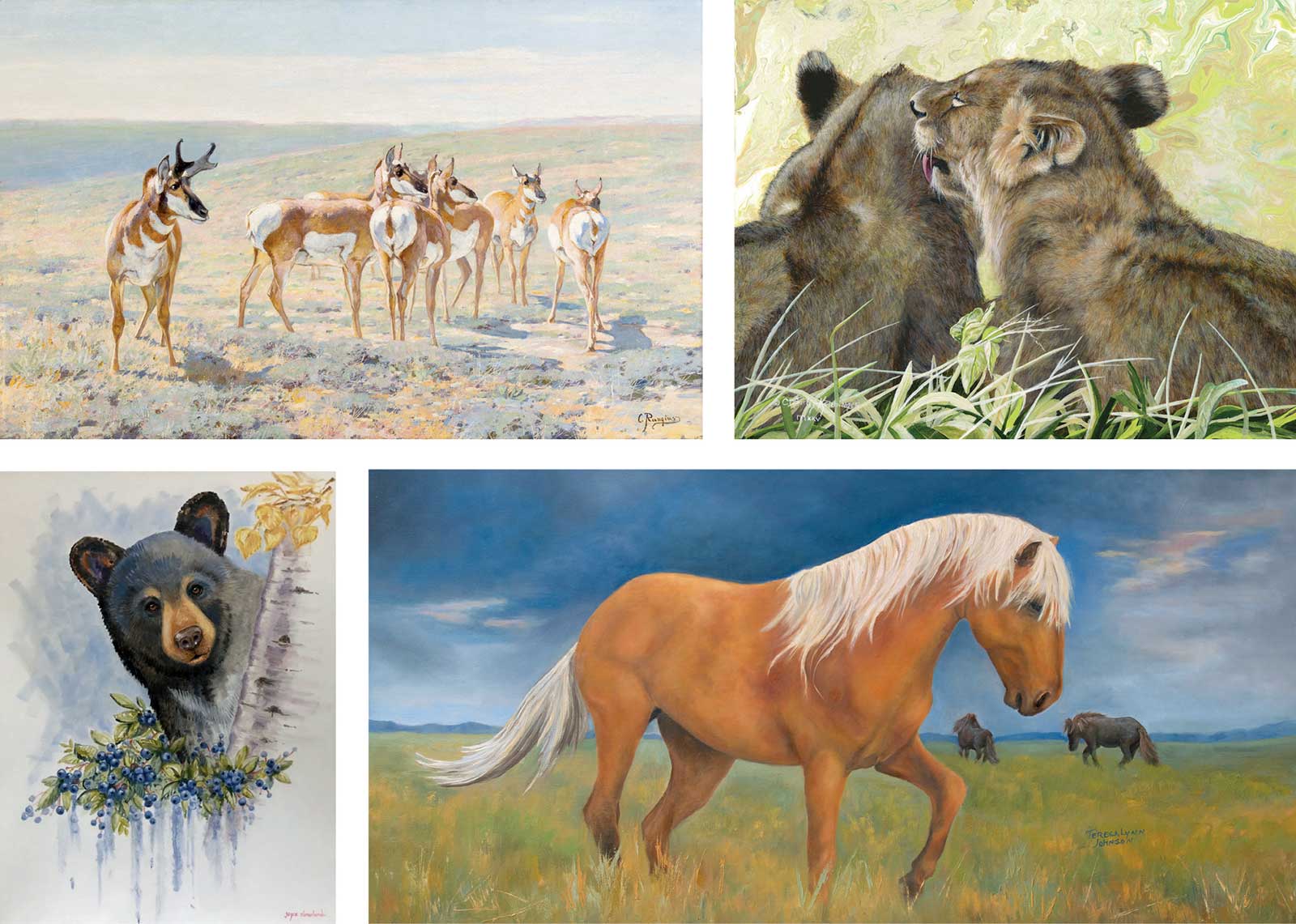
Top: Jackson Hole Art Auction, Pronghorn Antelope, oil on canvas, 29¼ x 46 in., by Carl Rungius (1869-1959). Estimate: $200/300,000; Cindy Sorley-Keichinger, Nap Time Buddies, acrylic, 11 x 14 in. Bottom: Joyce Cleveland, Blueberry Bear, oil on canvas, 24 x 18 in.; Teresa Lynn Johnson, All is Well, oil, 18 x 36 in.
SEWE artist Jim Killen’s work, like Covey Rise, cuts to the heart of the outdoor experience and will endure for as long as people treasure their dogs, gamebirds and waterfowl, as well as the unspoiled places that bring them all together. Julia Rogers draws inspiration from her extensive travels to paint her subjects. Wildlife has been a powerful source of inspiration in her work and remains a favorite subject. Observing animals in their natural habitats and witnessing their behavior firsthand has profoundly influenced the way she paints, bringing a deeper sense of connection and authenticity to each piece.
Paintings by some of the top living wildlife artists including Bonnie Marris, Daniel Smith, Robert Bateman and Carl Brenders are offered at J Watson Fine Art, with locations in California and Wyoming. “Marris has been an invited participant in the Masters of the American Westshow at the Autry Museum,” notes gallery owner Joanne Watson. “Her wildlife art is very well collected. Marris has made many trips in nature, photographing wildlife up close. She strives to convey the spirit or personality of the wildlife she paints. The passion Marris has for wilderness, for animals, and for light and color come together in her art. Smith is known for his highly realistic paintings of wildlife. He has won many museum awards including from the National Museum of Wildlife Art and the National Cowboy & Western Art Museum. Smith has also been the artist of the year for several conservation organizations, and he has used his art to help in conservation efforts.”
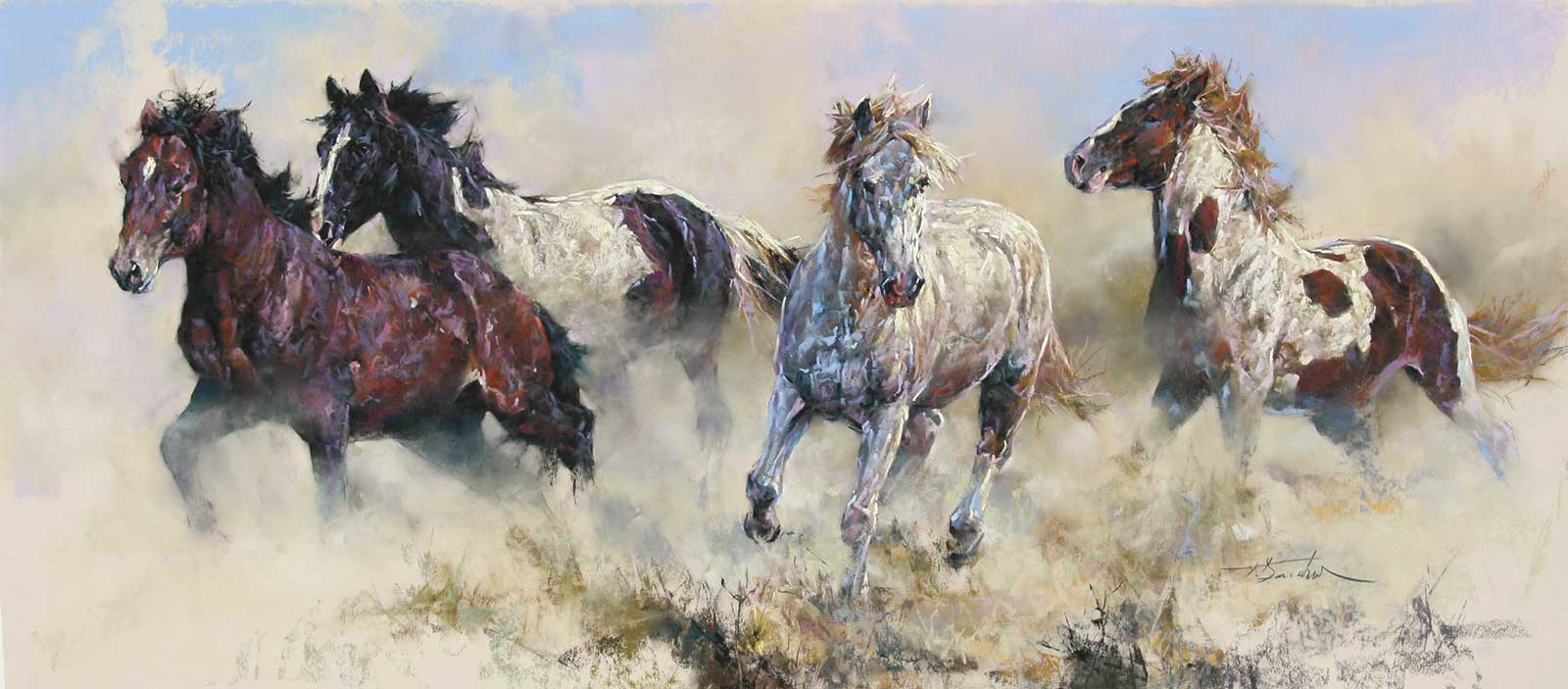
Terry Donahue, Dustup, pastel on Stonehenge paper, 17 x 39 in.
Duane Frey’s artwork focuses on the perfect imperfections that nature effortlessly displays for us every day. Creating his drawings in graphite allow him to bring these flaws to life in raw, intricate detail. He spends countless hours meticulously capturing the unique story of each animal he draws. “Their story always begins with the emotions shown in their eyes,” he notes. “Whether it is excitement, weariness or caution, I believe the eyes are the clearest view into the soul of an animal. The story continues by highlighting the texture of their fur, the scars they carry, the matting and the debris left by the environments they survive in. I complete their tale by capturing the tension or ease in their muscles. Telling their story with nothing but a pencil and a fleeting snapshot of their life is humbling and endlessly inspiring. It is a privilege to be able to share these brief moments with others through my art.”
Artist Cindy Sorley-Keichinger finds her landscape and wildlife subjects calming, and tries to project that in her work. “In today’s busy world, a little bit of calm and peace is a necessity,” she says. Sorley-Keichinger works primarily in acrylic but also uses gouache and oil. She is a member of several organizations like the Artists for Conservation and the Society of Animal Artists. An upcoming show for the artist is the September 2025 Artists for Conservation Showin Vancouver, Canada.
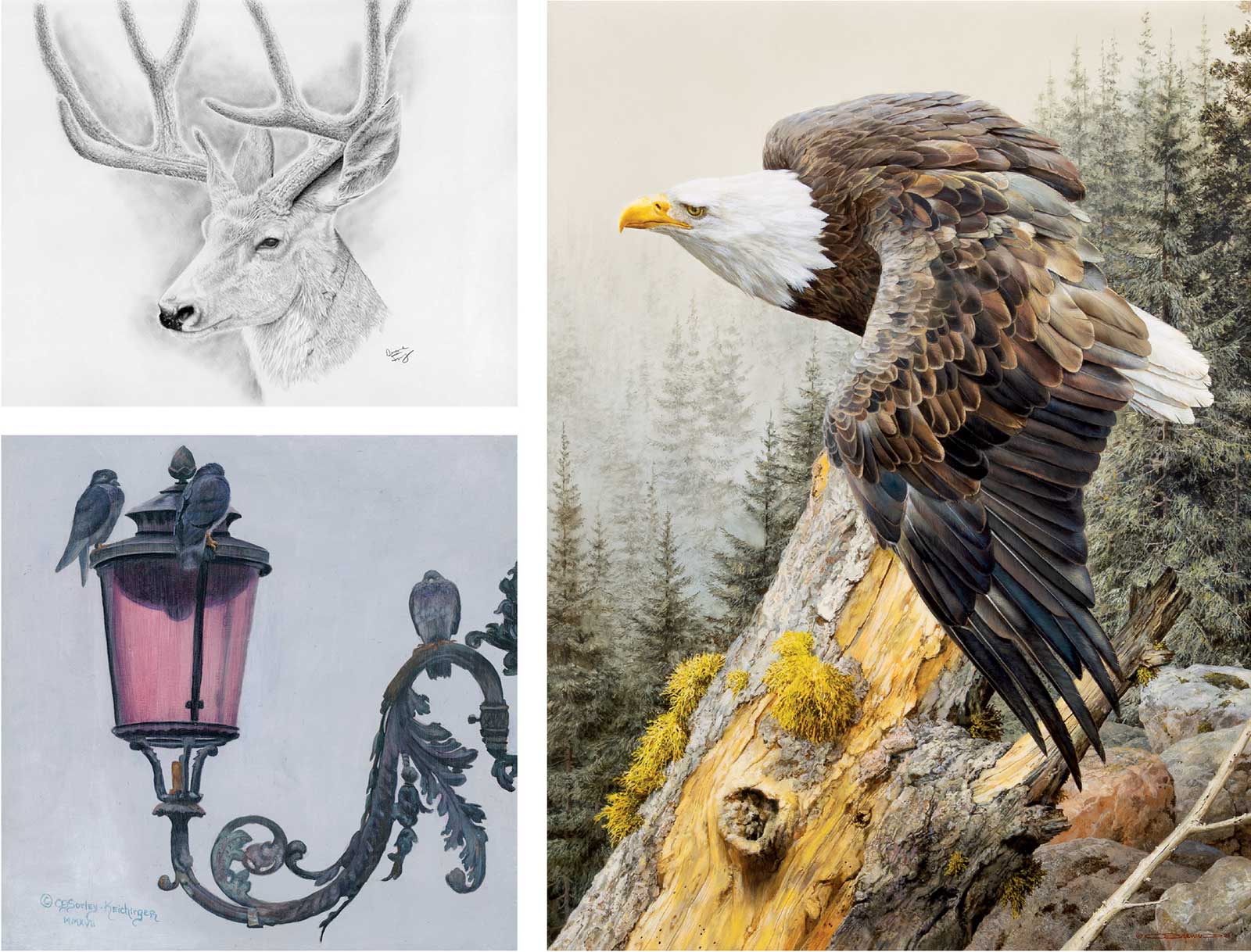
Clockwise from top left: Duane Frey, Velvet, graphite, 19 x 23 in.; Jackson Hole Art Auction, America on the Rise, mixed media on panel, 38 x 29 in., by Carl Brenders. Estimate: $60/90,000; Cindy Sorley-Keichinger, Foggy Perch, acrylic, 8 x 8 in.
“We are not the only ones on the planet, and I would like people to see and enjoy images of our neighbors,” Sorley-Keichinger says of her overall purpose. “To see and know something is to take an interest in it, and to care for it. Urban life, and to a lesser degree, rural life, insulates us from the world around us. I hope to introduce people to what they do not see every day, and to see beauty in what they do see.”

Gary Johnson, Black Bear Generations, mixed media on handmade mulberry paper, 9 x 19 in.; Gary Johnson, Guardian of the Young, oil on linen, 36 x 48 in.
Teresa Lynn Johnson creates artwork that encompasses a diverse range of subjects; however, she has a particular affinity for depicting animals, especially wildlife native to the western United States. “Living in a region that affords frequent opportunities to observe animals in their natural habitats or at wildlife refuge centers, allows me to study them and gather valuable reference materials for my artistic process,” she says. “I am continually inspired by the beauty, grace, independence and adaptability of animals. I am also guided by Aristotle’s observation: ‘In all things of nature, there is something of the marvelous.’ I love to capture that ‘something of the marvelous’ on canvas, to share with the world.”
Inspiration came to artist Joyce Cleveland when driving slowly along the backroads outside of Jackson Hole when a black bear peeked his head out from behind an aspen tree. “Upon seeing me, he looked quite surprised,” she says. “He was enjoying one of his favorite foods—blueberries! It was such a sweet moment that the image stayed with me. By the time I arrived home, I knew I would paint The Blueberry Bear.”
In another of Cleveland’s wildlife pieces, she was inspired during a late summer afternoon. “The sun was starting to set and reflected a beautiful orange glow on a bison and her calf,” the artist shares. “I knew it would be a perfect painting, and I called it Another Hot Summer.”
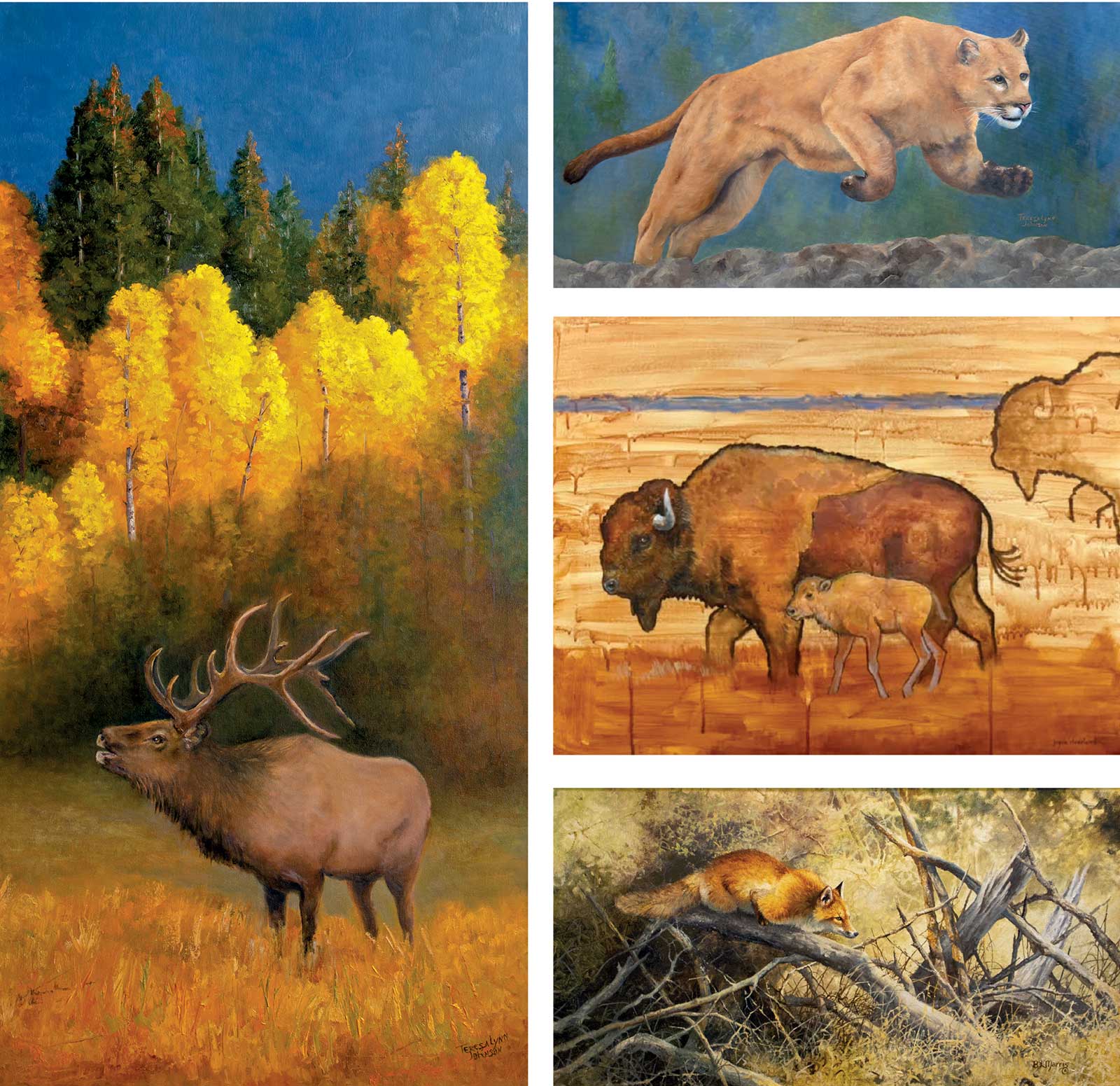
Clockwise from left: Teresa Lynn Johnson, Call of Autumn, oil, 40 x 20 in.; Teresa Lynn Johnson, Eye on the Prize, oil, 18 x 36 in.; Joyce Cleveland, Another Hot Summer, oil on canvas, 22 x 28 in.; J Watson Fine Art, Red Fox, oil on canvas, 12 x 22 in., by Bonnie Marris.
Rana Jordahl captures her wildlife subjects in a mixture of abstraction and representative forms using thick, expressive brushstrokes. She enjoys creating paintings for the infinite possibilities from which she has to choose: a bird’s wings in flight, the cast light of an object onto another, the motion of water and the sparkling light on its surface. “Whatever I want to convey about my subjects—softness, drama, light and shadow, energy, color—it is endlessly challenging, and it inspires me to paint every day.”
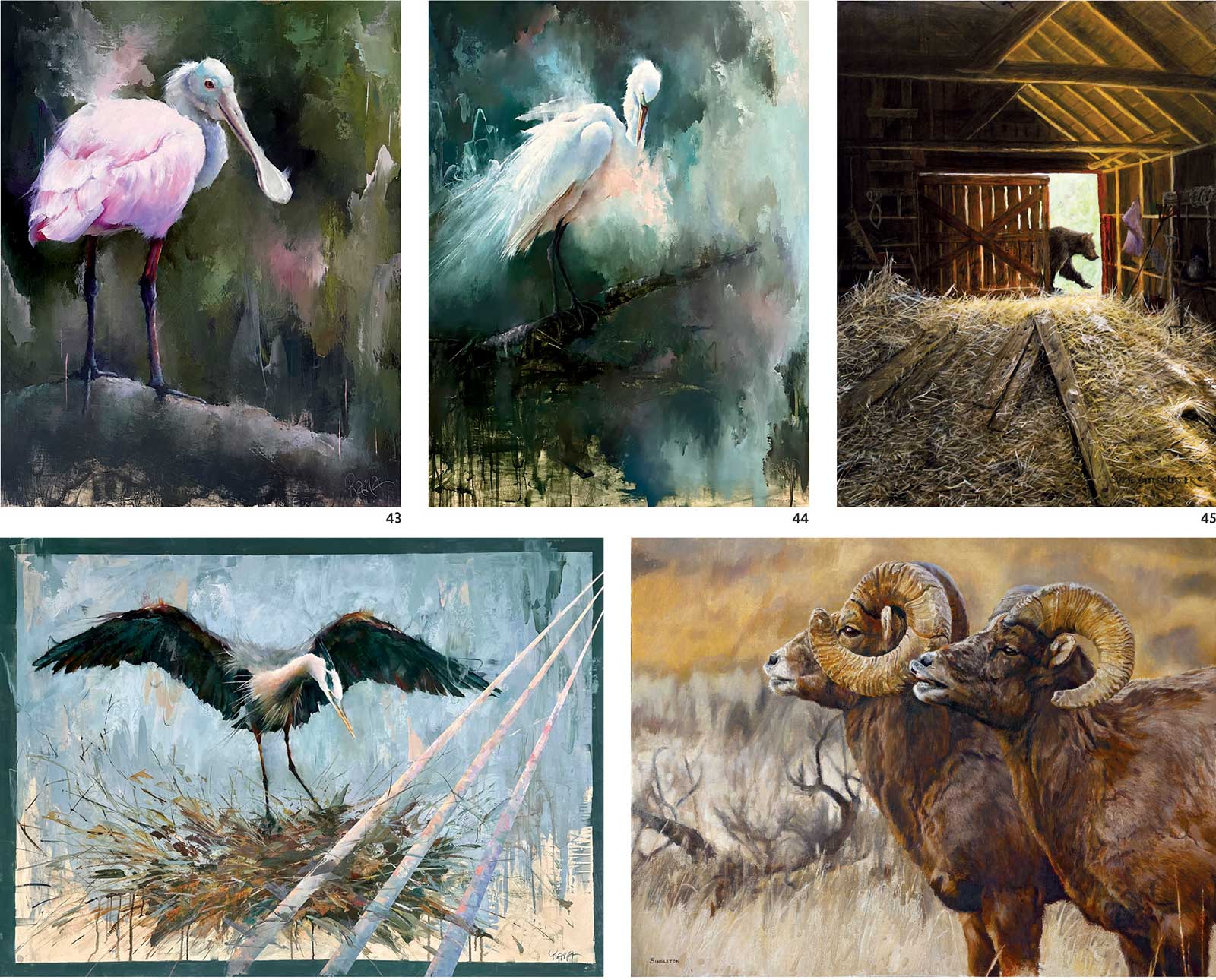
Top: Rana Jordahl, Marshland in Pink Accord, oil, 20 x 16 in.; Rana Jordahl, UnEGRETably Beautiful, oil, 40 x 30 in.; Suzie Seerey-Lester, Honey Pot, acrylic, 16 x 12 in. Bottom: Rana Jordahl, Ravenel Bridge Blue, oil, 36 x 48 in.; Kelly Singleton, The Time is Near, oil, 18 x 24 in.
Jordahl has a love for painting the animals that she grew up around from her Midwest upbringing, as well as from the Lowcountry, including blue herons, egrets, roseate spoonbills, other shorebirds, shrimp, cows and chickens.
When collecting, Jordahl suggests “building a relationship with your favorite artists and the galleries that represent them. By doing that, a collector will gain a deeper understanding of the artist’s work and their process, leading to more meaningful acquisitions. Additionally, do not allow decorating trends to dictate your art purchases. Follow your heart and only buy what speaks to you personally. Those carefully curated pieces will continue to be loved for years to come.”
Kelly Singleton’s inspiration stems from her profound connection to nature and wildlife. Observing animals in their natural habitats and photographing them for future paintings fuels her creativity. “My process is driven by a desire to share these encounters,” she says. “Through careful use of texture, light and depth, I bring my subjects to life, reflecting their true spirit. My work is grounded in a deep respect for animals, and a belief that art can inspire greater appreciation and conservation of the natural world.”
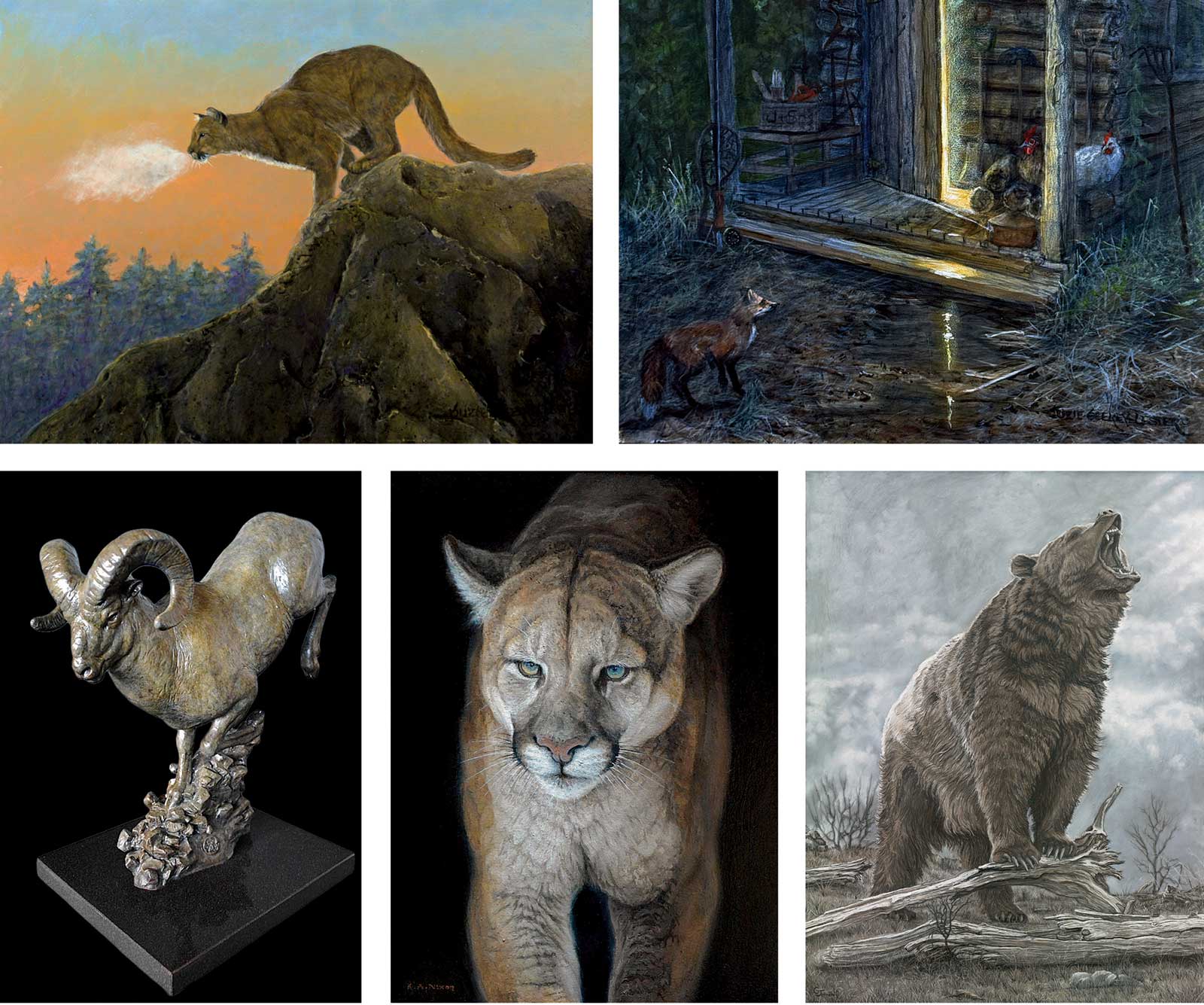
Top: Suzie Seerey-Lester, Twilight Alert, acrylic, 12 x 16 in.; Suzie Seerey-Lester, Late Night Visit, acrylic, 11 x 14 in. Bottom: Kasey A. Nixon, Down the Chute, bronze, ed. 12; Kasey A. Nixon, Heart of Stone, oil, 24 x 18 in.; Gary Johnson, Last Stand, charcoal and pastel, 32 x 24 in.
Singleton’s piece The Time is Near was inspired by observing a herd of bighorn sheep during the early stages of their rut. While the full action hadn’t yet begun, many rams were starting to stir. “One image that stood out featured a seasoned, battle-worn ram alongside a younger one performing the Flehmen response—a behavior where rams curl their lips to detect if an ewe is in heat and ready to breed,” she explains. “This moment perfectly captured the tension and anticipation of the season.”
Teaching at Triple D in Montana allows artist Suzie Seerey-Lester to photograph and paint wild animals in their natural habitat—mountain lions leap from rocks 5 feet away, a wolf pack races by at neck-breaking speed, snow leopards disappear on the mountain in front of you. “These are just a few of the species I work with to achieve realistic paintings of animals you will probably never see in the wild,” she adds. “You are there to experience these animals without bars or cages, where you are 3 feet away from a grizzly bear, and you can experience foxes racing between your feet in their game of catch.”
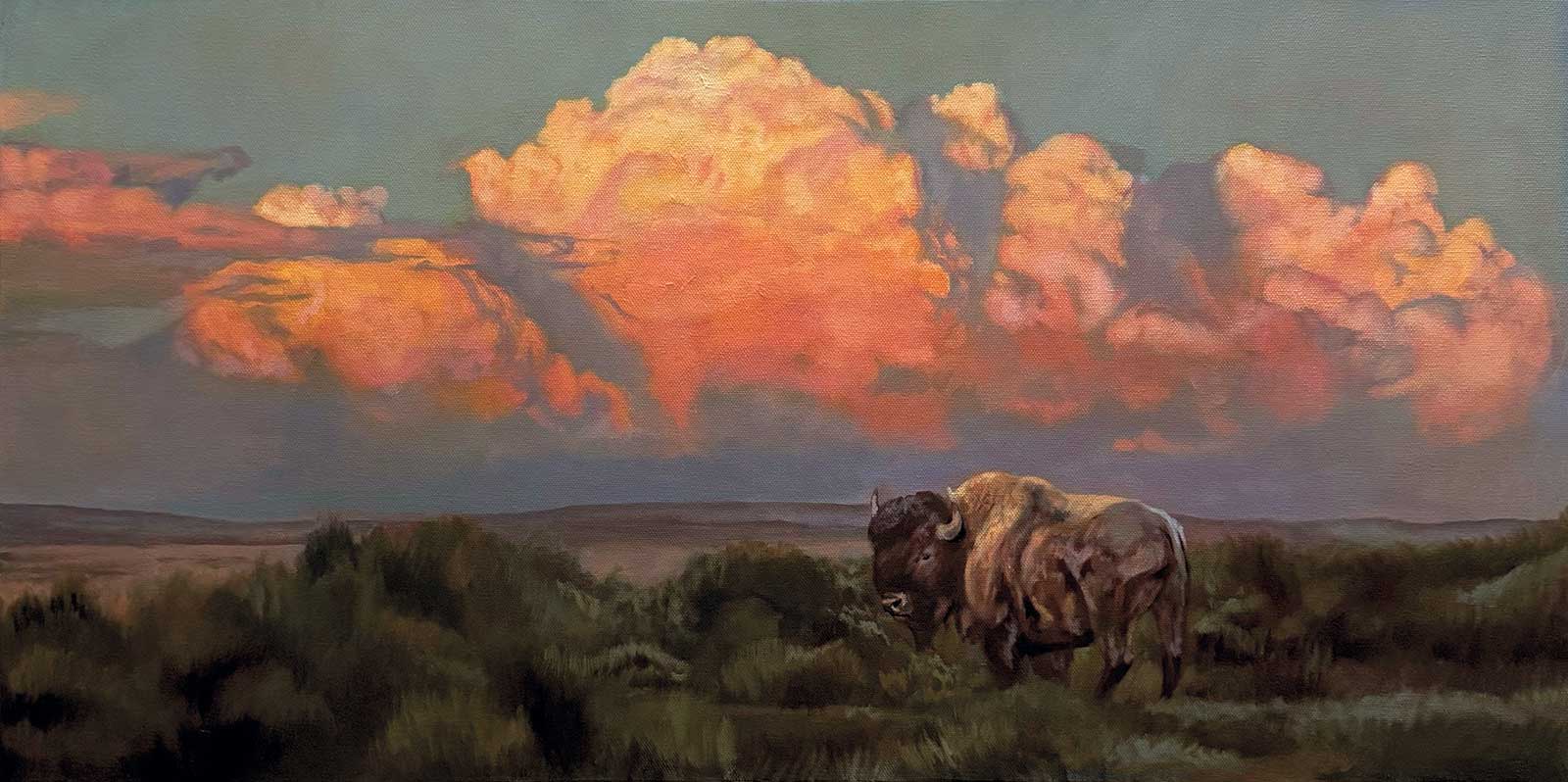
Summer Spitsbergen, Intermission, oil, 15 x 20 in.
Artists and collectors can join Seerey-Lester’s class in October 2025, where they can take their art to the next level.
Born and raised in Montana, Kasey A. Nixon’s art stems from his experiences in nature. As an avid outdoorsman, Nixon finds inspiration for his work while fishing and hunting in the rivers and mountain ranges of the West, and around the world from Africa to New Zealand. “For me, a piece of art is not simply a recording of a scene, but a unique statement of the experience, and the emotions felt while encountering nature,” he says. “The subjects of my work are the things that have deep, personal meaning to me, and there is always a strong and very personal memory attached. My hope is that the viewer will be able to concisely understand the scene being portrayed, as well as experience an emotional response of their own.”
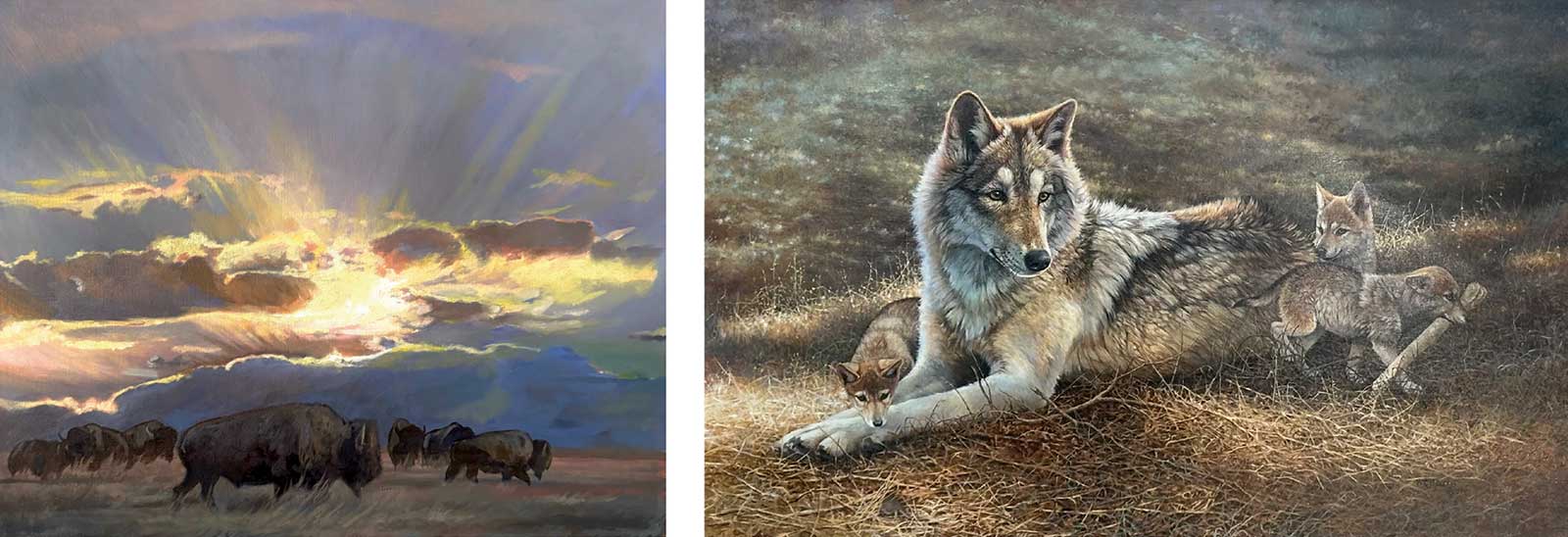
Summer Spitsbergen, The Roaming, oil, 16 x 20 in.; J Watson Fine Art, Wolf Family Cops and Robbers, oil on canvas, 30 x 48 in., by Bonnie Marris.
Nixon strives for excellence in both two and three dimensions. He states, “The artists I admire most have achieved mastery in numerous art forms from sculpture to painting.”
Over his career, Gary Johnson has painted a variety of wildlife from the world over. “One subject I have a special connection with are bears,” he says. “I have painted bears using a variety of mediums: oils, watercolors, pastel, charcoal, pencil and gouache. Last Stand, for example, is a roaring grizzly bear painted with charcoal and pastel on sandpaper board. Guardian of the Young is a commissioned oil painting of a sow grizzly bear protecting her two cubs from a small pack of wolves; and Black Bear Generationsis a diptych portrait of a sow and a cub black bear. These paintings are the same size created on handmade mulberry using a mixed process with pastel pencil, watercolor, gouache and gold mica.” Find Johnson’s work at Going to the Sun Gallery in Whitefish, Montana, and Oregon Coast Galleries in Florence, Oregon.
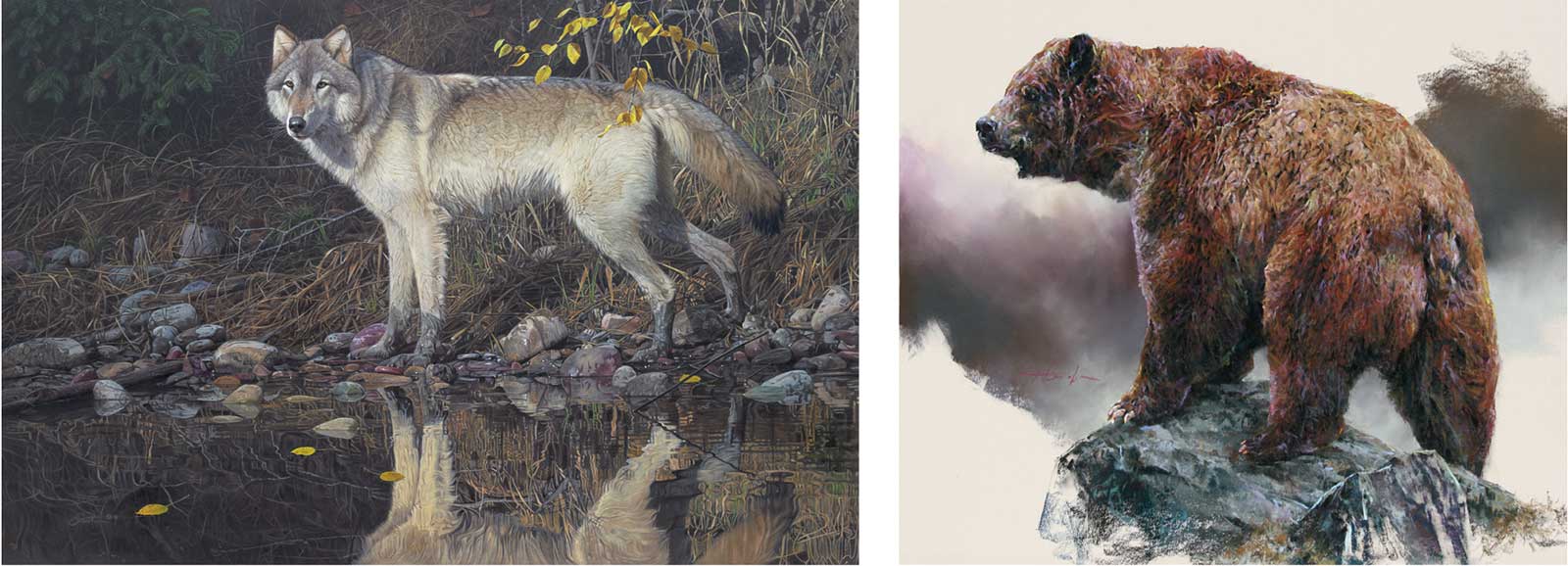
J Watson Fine Art, Shoreline Reconnaissance, acrylic on board, 24 x 36 in., by Daniel Smith.; Terry Donahue, Perch, pastel on Stonehenge paper, 28¼ x 32 in.
For artist Summer Spitsbergen, to capture her wildlife subjects, a lot of time is spent between the beautiful states of Colorado, Montana, Oregon and sometimes Arizona. “Between those places, sights often contain breathtaking natural views that I do my best to soak in and sometimes paint on the spot,” she notes. “My family is from Colorado, and I sometimes go up into the Rocky Mountains with my dad on his mountain horses, where we will spot herds of elk. I am blessed enough to live in an area where bison are present. Between our family ranch in Oregon and travels throughout the Western United States, I am surrounded by natural beauty that I use in my work. Whether a bison, elk or the working cowboy, my paintings are inspired by my everyday life. I often hear from my collectors that they can feel my connection to the subject matter and subsequently they can connect to it as well.”
When creating an image, Terry Donahue’s foremost pursuit is to capture his perspective of nature. “When creating, I want there to be no ambiguity, I want the viewer to immediately recognize my work through my style,” the artist says. “Working in pastels lends itself perfectly to my drawing style—characterized by loose, untamed strokes, which creates a sense of captured motion. Using negative space to help create the composition thus allows each viewer’s imagination their own interpretation.”
An example of Donahue’s skill and vision can be seen in works like Perch and Dustup.
Featured Artists & Galleries
Altamira Fine Art
172 Center Street #100, Jackson Hole, WY 83001
(307) 739-4700
www.altamiraart.com
Joyce Cleveland
clevel1858@aol.com
www.joyceclevelandfineart.com
Coeur d’Alene Galleries
213 E. Sherman Avenue, Coeur d’Alene, ID 83814
(208) 667-7732
www.cdagalleries.com
Terry Donahue
(402) 250-5839
terry.donahue75@gmail.com
www.terrydonahueart.com
Duane Frey
(701) 509-0724, contact@duanefrey.com
www.duanefrey.com
Gallery Wild
80 W. Broadway, Jackson Hole, WY 83001
(307) 203-2322, info@gallerywild.com
www.gallerywild.com
J Watson Fine Art
California & Wyoming
(661) 476-7558
www.jwatsonfineart.com
Jackson Hole Art Auction
130 E. Broadway Avenue, Jackson Hole, WY 83001
(307) 734-9739 coordinator@jacksonholeartauction.com
www.jacksonholeartauction.com
Gary Johnson
(760) 402-9986
www.garyjohnson.com
Instagram: garyjohnsonstudio
Teresa Lynn Johnson
Aztec, NM, (505) 334-1744
www.teresalynnjohnson.com
Instagram: teresalynnjohnsonartist
Rana Jordahl
Charleston, SC, (843) 270-4896
www.ranajordahl.com
Instagram: ranajordahl_fineart
Manitou Galleries
123 W. Palace Avenue, Santa Fe, NM 87501
(505) 986-0440
www.legacygallery.com
Mountain Trails Gallery Sedona
336 SR 179, Suite A201, Sedona, AZ 86336
(928) 282-3225
fineart@mountaintrailssedona.com
www.mountaintrailssedona.com
National Museum of Wildlife Art
2820 Rungius Road, Jackson, WY 83001
(307) 733-5771, www.wildlifeart.org
Kasey A. Nixon
kaseynixon@gmail.com
www.kanixonfineart.com
Instagram: kaseynixonart
Suzie Seerey-Lester
seereylester@msn.com
www.seerey-lester.com
www.seerey-lester-art.com
Kelly Singleton
(443) 528-8908
kelly@kellysingleton.com
www.kellysingleton.com
Instagram: kellylsingleton
Southeastern Wildlife Exposition
211 Meeting Street, Second Floor
Charleston, SC 29401
(843) 723-1748
sewe@sewe.com
www.sewe.com
Cindy Sorley-Keichinger
(780) 847-2294, goldfarm@telusplanet.net
www.goldenkstudio.com
www.picturethisgallery.com
Summer Spitsbergen
(619) 889-7770
www.summerspitsbergen.com
Powered by Froala Editor
